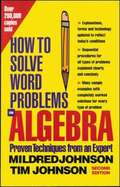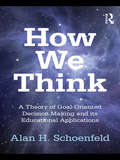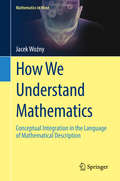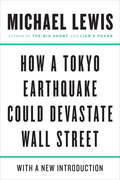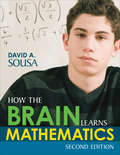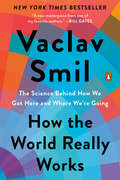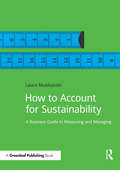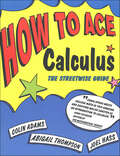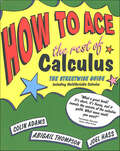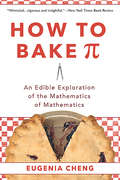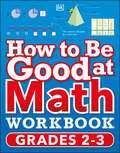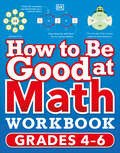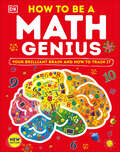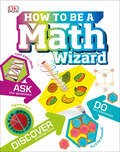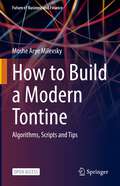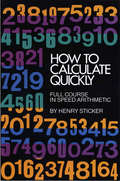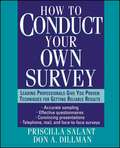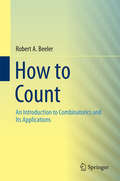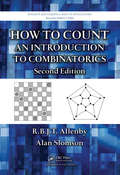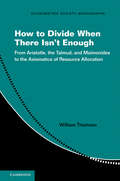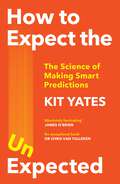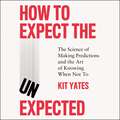- Table View
- List View
How To Solve Word Problems In Algebra, 2nd edition
by Mildred Johnson Tim Johnson"There is no area in algebra which causes students as much difficulty as word problems. Most textbooks in algebra do not have adequate explanations and examples for the student who is having trouble with them...All major types of word problems usually found in algebra texts are here. Emphasis is on the mechanics of word-problem solving because it has been my experience that students having difficulty can learn basic procedures even if they are unable to reason out a problem." Author.
How We Think: A Theory of Goal-Oriented Decision Making and its Educational Applications (Studies in Mathematical Thinking and Learning Series)
by Alan H. SchoenfeldTeachers try to help their students learn. But why do they make the particular teaching choices they do? What resources do they draw upon? What accounts for the success or failure of their efforts? In How We Think, esteemed scholar and mathematician, Alan H. Schoenfeld, proposes a groundbreaking theory and model for how we think and act in the classroom and beyond. Based on thirty years of research on problem solving and teaching, Schoenfeld provides compelling evidence for a concrete approach that describes how teachers, and individuals more generally, navigate their way through in-the-moment decision-making in well-practiced domains. Applying his theoretical model to detailed representations and analyses of teachers at work as well as of professionals outside education, Schoenfeld argues that understanding and recognizing the goal-oriented patterns of our day to day decisions can help identify what makes effective or ineffective behavior in the classroom and beyond.
How We Understand Mathematics: Conceptual Integration In The Language Of Mathematical Description (Mathematics in Mind)
by Jacek WoźnyThis volume examines mathematics as a product of the human mind and analyzes the language of "pure mathematics" from various advanced-level sources. Through analysis of the foundational texts of mathematics, it is demonstrated that math is a complex literary creation, containing objects, actors, actions, projection, prediction, planning, explanation, evaluation, roles, image schemas, metonymy, conceptual blending, and, of course, (natural) language. The book follows the narrative of mathematics in a typical order of presentation for a standard university-level algebra course, beginning with analysis of set theory and mappings and continuing along a path of increasing complexity. At each stage, primary concepts, axioms, definitions, and proofs will be examined in an effort to unfold the tell-tale traces of the basic human cognitive patterns of story and conceptual blending. This book will be of interest to mathematicians, teachers of mathematics, cognitive scientists, cognitive linguists, and anyone interested in the engaging question of how mathematics works and why it works so well.
How Well Do Executives Trust Their Intuition (Data Analytics Applications)
by Yolande Chan Fabio Babiloni Joanna Paliszkiewicz Jay Liebowitz Tracy Jenkin Dylan SpickerIn this age of Big Data and analytics, knowledge gained through experiential learning and intuition may be taking a back seat to analytics. However, the use of intuition should not be underestimated and should play an important role in the decision process. <P><P>How Well Do Executives Trust Their Intuition covers the Fulbright research study conducted by this international team of editors. The main question of their investigation is: How well do executives trust their intuition? In other words, do they typically prefer intuition over analysis and analytics. And equally importantly, what types of intuition may be most favorable looking at different variables? The research utilizes survey and biometrics approaches with C-level executives from Canada, U.S., Poland, and Italy. <P><P>In addition, the book contains chapters from leading executives in industry, academia, and government. Their insights provide examples of how their intuition enabled key decisions that they made. <P><P>This book covers such topics as: <li>Using intuition <li>How gender, experience, role, industry, and country affect intuition <li>Trust and intuition in management <li>Trusting intuition <li>It’s a matter of heart <li>Leadership intuition and the future of work <li>Creating an intuitive awareness for executives <li>Improvisation and instinct. <P><P>The book explores how executives can use intuition to guide decision making. It also explains how to trust intuition-based decisions. How Well Do Executives Trust Their Intuition is a timely and prescient reminder in this age of data-driven analytics that human insight, instinct, and intuition should also play key roles.
How a Tokyo Earthquake Could Devastate Wall Street
by Michael LewisIn 1989, Michael Lewis reported on the potential effects of an earthquake in Japan on world financial markets. His insights are once again timely, and they are presented here as a stand-alone essay with a new introduction: "Real Versus Imaginary Japanese Earthquakes." In the late 1980s, Japanese scientists were trying to figure out the economic damage that would be caused if a catastrophic earthquake destroyed Tokyo. The answer was bleak, but not for Japan. Kaoru Oda, an economist who worked for Tokai Bank, speculated that the United States would end up paying the most. Why? Japan owned trillions of dollars' worth of foreign liquid assets and investments. These assets, which the world depended on, would be sold, forcing countries into the precarious position of having to return large amounts of money they might not have. After the recent earthquake, Michael Lewis reexamined this hypothesis and came to a surprising conclusion. With his characteristic sense of humor and wit, Lewis, once again, explains the inner workings of a financial catastrophe. "How a Tokyo Earthquake Could Devastate Wall Street" appears in Michael Lewis's book The Money Culture.
How the Brain Learns Mathematics
by Dr David A. SousaTo reach all your math students, use your brain—and theirs, too! This updated bestseller takes readers to the next level with new brain-friendly strategies backed by the latest research and even more ways to seamlessly incorporate what you learn about your students’ developing minds into your math classroom. Discover the cognitive mechanisms for learning math, explore factors that contribute to learning difficulties, and follow a four-step teaching model that relates classroom experience to real-world applications. Features include: New strategies for motivating adolescents Integration of the arts into mathematics instruction New information on how technology affects attention and memory Expanded sections on number sense and ELL instruction More than 160 new references
How the World Really Works: The Science Behind How We Got Here and Where We're Going
by Vaclav SmilINSTANT NEW YORK TIMES BESTSELLER&“A new masterpiece from one of my favorite authors… [How The World Really Works] is a compelling and highly readable book that leaves readers with the fundamental grounding needed to help solve the world&’s toughest challenges.&”—Bill Gates &“Provocative but perceptive . . . You can agree or disagree with Smil—accept or doubt his &‘just the facts&’ posture—but you probably shouldn&’t ignore him.&”—The Washington PostAn essential analysis of the modern science and technology that makes our twenty-first century lives possible—a scientist's investigation into what science really does, and does not, accomplish.We have never had so much information at our fingertips and yet most of us don&’t know how the world really works. This book explains seven of the most fundamental realities governing our survival and prosperity. From energy and food production, through our material world and its globalization, to risks, our environment and its future, How the World Really Works offers a much-needed reality check—because before we can tackle problems effectively, we must understand the facts. In this ambitious and thought-provoking book we see, for example, that globalization isn&’t inevitable—the foolishness of allowing 70 per cent of the world&’s rubber gloves to be made in just one factory became glaringly obvious in 2020—and that our societies have been steadily increasing their dependence on fossil fuels, such that any promises of decarbonization by 2050 are a fairy tale. For example, each greenhouse-grown supermarket-bought tomato has the equivalent of five tablespoons of diesel embedded in its production, and we have no way of producing steel, cement or plastics at required scales without huge carbon emissions. Ultimately, Smil answers the most profound question of our age: are we irrevocably doomed or is a brighter utopia ahead? Compelling, data-rich and revisionist, this wonderfully broad, interdisciplinary guide finds faults with both extremes. Looking at the world through this quantitative lens reveals hidden truths that change the way we see our past, present and uncertain future.
How to Account for Sustainability: A Simple Guide to Measuring and Managing (Doshorts Ser.)
by Laura MusikanskiLearn how to measure, manage and account for sustainability in your business in clear, simple and feasible steps.This book takes you from concept to innovation and back to action items for all aspects of sustainability. Each chapter has four sections: (1) a specific description of sustainability challenges, (2) an example of a business making a profit by sustainability problem, (3) an exercise challenging the reader to identify business solutions and (4) clear, simple takeaways.The book is structured around the world’s most accepted guidelines for sustainability reporting, the Global Reporting Initiative.
How to Ace Calculus: The Streetwise Guide
by Joel Hass Colin Adams Abigail ThompsonWritten by three gifted-and funny-teachers, How to Ace Calculus provides humorous and readable explanations of the key topics of calculus without the technical details and fine print that would be found in a more formal text. Capturing the tone of students exchanging ideas among themselves, this unique guide also explains how calculus is taught, how to get the best teachers, what to study, and what is likely to be on exams-all the tricks of the trade that will make learning the material of first-semester calculus a piece of cake. Funny, irreverent, and flexible, How to Ace Calculus shows why learning calculus can be not only a mind-expanding experience but also fantastic fun.
How to Ace the Rest of Calculus: The Streetwise Guide (How to Ace)
by Joel Hass Colin Adams Abigail ThompsonThe sequel to How to Ace Calculus, How to Ace the Rest of Calculus provides humorous and highly readable explanations of the key topics of second and third semester calculus-such as sequences and series, polor coordinates, and multivariable calculus-without the technical details and fine print that would be found in a formal text.
How to Bake Pi: An Edible Exploration of the Mathematics of Mathematics
by Eugenia ChengWhat is math? How exactly does it work? And what do three siblings trying to share a cake have to do with it? In How to Bake Pi, math professor Eugenia Cheng provides an accessible introduction to the logic and beauty of mathematics, powered, unexpectedly, by insights from the kitchen: we learn, for example, how the béchamel in a lasagna can be a lot like the number 5, and why making a good custard proves that math is easy but life is hard. Of course, it's not all about cooking; we'll also run the New York and Chicago marathons, take a closer look at St. Paul's Cathedral, pay visits to Cinderella and Lewis Carroll, and even get to the bottom of why we think of a tomato as a vegetable. At the heart of it all is Cheng's work on category theory, a cutting-edge "mathematics of mathematics," that is about figuring out how math works. This is not the math of our high school classes: seen through category theory, mathematics becomes less about numbers and formulas and more about how we know, believe, and understand anything, including whether our brother took too much cake.Many of us think that math is hard, but, as Cheng makes clear, math is actually designed to make difficult things easier. Combined with her infectious enthusiasm for cooking and a true zest for life, Cheng's perspective on math becomes this singular book: a funny, lively, and clear journey through a vast territory no popular book on math has explored before. How to Bake Pi offers a whole new way to think about a field all of us think we know; it will both dazzle the constant reader of popular mathematics and amuse and enlighten even the most hardened math-phobe.So, what is math? Let's look for the answer in the kitchen.
How to Be Good at Math Workbook Grades 2-3 (DK How to Be Good at)
by DKUnleash your child&’s inner math genius and help them master math for Grades 2 and 3!Whether you enjoy math or not, it&’s an essential subject to understand. See how everything adds up with this fully illustrated home-study guide.Get inspired by numbers and see how mathematical explanations come to life with this engaging math book for kids! It includes: • Full color, with a clear layout. • Clear instructions that are easy for children to follow by themselves. • Answers that are given at the back of the book. • Practice questions and practical exercises to help expand your child&’s knowledge of the subject. Make math manageableHow to be Good at Math Grade 2-3 keeps the math simple and easy to understand! It comes packed with eye-catching illustrations and easy-to-follow instructions to teach kids everything they need to know about math. This brilliant visual math workbook is ideal for reinforcing classroom teaching. It helps kids understand what they&’ve learned in school and gives them extra math revision practice before an important test!Perfect for kids ages 7-9, this colorful math practice book covers all the key areas of the school curriculum for this level. It includes fractions, multiplication, divisio, measurement, geometry, coordinates, data handling and graphs. And there are answers at the back to check that you're on the right path.This engaging and clear workbook accompanies How to be Good at Math Grade 4-6, which covers ages 9-11 (Grades 4, 5, and 6).Discover How to be Good in other subjectsDK&’s successful How to be Good at... workbook series provides your child with the tools to learn how to look at the world around them and figure out how it works. There are more books to discover! Learn all about the influence of science and technology in the modern age with How to Be Good at Science, Technology, and Engineering.
How to Be Good at Math Workbook, Grades 4-6: The simplest–ever visual workbook (DK How to Be Good at)
by DKHelp your child learn and master grade 4, 5 and 6 math in no timeWhether you&’re good at math or not, it&’s an essential subject to understand. Luckily, you don&’t have to be a math genius to follow along with this fully illustrated home-study guide!Get inspired by numbers and see how mathematical explanations come to life with this engaging math book for kids! It includes: • Full color pages, with clear, and easy to comprehend layouts • Clear instructions that are easy for children to follow by themselves. • Answer guides at the back of the book • Practice questions and practical exercises to help expand your child&’s knowledge of the subject. Make math manageablePacked with eye-catching illustrations and easy-to-follow instructions, How to be Good at Math Grade 4-6 continues to keep the math simple and easy to understand for kids! This brilliant visual math workbook teaches them everything they need to know about math. Ideal for reinforcing classroom teaching, it helps kids understand what they&’ve learned in school and gives them extra math revision practice before an important test!Perfect for children ages 9-11, this colorful math practice book covers all the key areas of the school curriculum for this level. It includes working with fractions and decimal numbers, percentages, long multiplication and division, measurement, geometry, coordinates, statistics, probability and basic algebra. And there are answers at the back to check that you&’re on the right path.This engaging and clear workbook accompanies How to be Good at Math Grade 2-3, which covers ages 7-9 (Grades 2 and 3).Help your child get better in other topicsDK&’s successful How to be Good at... workbook series provides your child with the tools to learn how to look at the world around them and figure out how it works. There are more books to discover! Learn all about the influence of science and technology in the modern age with How to Be Good at Science, Technology, and Engineering.
How to Be a Math Genius: Your Brilliant Brain and How to Train It (DK Train Your Brain)
by DKRefine your math skills and be well on your way to becoming a numbers whizz!Learn about the intriguing and wonderful world of mathematics, how your brain works to interpret numbers and shapes, and how to improve your math skills in this informative math book. This educational fact-filled guide to math will have you beaming with newfound knowledge. It includes: • Fun things to do, from brainteasers to puzzles • Clear, engaging text that demystifies math • Tips and techniques to help you boost their brainpower • Brand new biographies of pioneering mathematicians, such as Grace Hopper and Katherine Johnson • Lively illustrations that bring the topic to life and make the subject matter engaging for kids • Creative math exercises and activities put kids&’ skills to the test This informative educational book allows young readers to understand the basic ideas behind math. It not only teaches new math skills, but also provides them with greater confidence in their own ability to handle numbers and mathematical problems. How To Be A Math Genius puts the ideas into context to help children understand why math is useful and even exciting! Uncover the amazing sphere of algebra, puzzling primes, super sequences and special shapes. Challenge yourself with thrilling quizzes, solve dynamic puzzles and crack complex codes and inspirational geometrical illusions. Learn about the big names and even bigger brains who made mathematical history such as Pythagoras, Grace Hopper and Alan Turing. The books in the Train Your Brain series make complex subjects fun, accessible and exciting, and are perfect for any child! Journey through science subjects at home and have fun with clever activities! Other books in the series include Train Your Brain: How to be a Genius.
How to Be a Math Wizard (Careers for Kids)
by DKBring math to life with this exciting new math activity book for kids.With 30 activities and crafts that children can play their way through, this kids' book takes the fear out of math--and gives you the skills to become a math expert. Children will find out that being a mathematician isn't just about scrawling numbers on a dusty chalkboard--it's part of our everyday lives! How to Be a Math Wizard teaches kids to think like math pros as they ask mathematical questions and get hands-on with key math concepts. From calculation and numbers; to space, shape, and measure; all core curriculum math topics are covered in creative and engaging ways. This book invites kids to investigate math in a playful, hands-on way, using things from around the house: find out about perimeter by designing and building a mini house, practice multiplication through a game of bingo, sweeten probability through chocolate, and uncover the mystery of coordinates through a treasure map.If you like solving problems, making things, and learning facts, then this is the book for you, mathematician!
How to Build a Modern Tontine: Algorithms, Scripts and Tips (Future of Business and Finance)
by Moshe Arye MilevskyThis open access book introduces the modern tontine and its applications in retirement and decumulation. Personal financial management in the later stages of life presents unique challenges, and renowned retirement planning expert Dr. Milevsky proposes the modern tontine as a solution. With the goal of guiding professionals and retirees in more efficient decumulation, the book demonstrates how to build a modern tontine. It is technically oriented, employing a cookbook format, featuring R code, and examining retirement planning through a statistical lens. This how-to guide, which is a sequel to his 2020 book “Retirement Income Recipes in R”, will be invaluable for retirement planning professionals and advisors, as well as for PhD scholars in retirement planning, quantitative finance, and related fields.This book is open access.
How to Calculate Quickly: Full Course in Speed Arithmetic (Dover Books on Mathematics)
by Henry StickerDo you want to double or triple the speed with which you calculate? How to Calculate Quickly is a tried and true method for helping you in the mathematics of daily life -- addition, subtraction, multiplication, division, and fractions. The author can awaken for you a faculty which is surprisingly dormant in accountants, engineers, scientists, businesspeople, and others who work with figures. This is "number sense" -- or the ability to recognize relations between numbers considered as whole quantities. Lack of this number sense makes it entirely possible for a scientist to be proficient in higher mathematics, but to bog down in the arithmetic of everyday life. This book teaches the necessary mathematical techniques that schools neglect to teach: Horizontal addition, left to right multiplication and division, etc. You will learn a method of multiplication so rapid that you'll be able to do products in not much more time than it would take to write the problem down on paper. This is not a collection of tricks that work in only a very few special cases, but a serious, capably planned course of basic mathematics for self-instruction. It contains over 9,000 short problems and their solutions for you to work during spare moments. Five or ten minutes spent daily on this book will, within ten weeks, give you a number sense that will double or triple your calculation speed.
How to Conduct Your Own Survey
by Don A. Dillman Priscilla SalantA nuts-and-bolts guide to conducting your own professional-quality surveys without paying professional fees. How can you gauge public support for a cause or test the market for a product or service? What are the best methods for validating opinions for use in apaper or dissertation? A well-documented survey is the answer. But what if you don't have thousands of dollars to commission one? N oproblem. How to Conduct Your Own Survey gives you everything you need to do it yourself! Without any prior training, you can learn expert techniques for conducting accurate, low-cost surveys. In step-by-step, down-to-earth language, Priscilla Salant and Don A. Dillman give you the tools you need to: Determine which type of survey is best for you Estimate the cost of your survey Conduct mail, telephone, and face-to-face surveys Draw accurate samples Write effective questionnaires Compile and report results Avoid common survey errors Find reliable outside assistance And much more
How to Count
by Robert A. BeelerProviding a self-contained resource for upper undergraduate courses in combinatorics, this text emphasizes computation, problem solving, and proof technique. In particular, the book places special emphasis the Principle of Inclusion and Exclusion and the Multiplication Principle. To this end, exercise sets are included at the end of every section, ranging from simple computations (evaluate a formula for a given set of values) to more advanced proofs. The exercises are designed to test students' understanding of new material, while reinforcing a working mastery of the key concepts previously developed in the book. Intuitive descriptions for many abstract techniques are included. Students often struggle with certain topics, such as generating functions, and this intuitive approach to the problem is helpful in their understanding. When possible, the book introduces concepts using combinatorial methods (as opposed to induction or algebra) to prove identities. Students are also asked to prove identities using combinatorial methods as part of their exercises. These methods have several advantages over induction or algebra.
How to Count to Infinity
by Marcus Du SautoyDo something amazing and learn a new skill thanks to the Little Ways to Live a Big Life books! Birds do it, bees do it, even educated fleas do it... Not falling in love, but counting. Animals and humans have been using numbers to navigate their way through the jungle of life ever since we all evolved on this planet. But this book will help you to do something that humans have only recently understood how to do: to count to regions that no animal has ever reached. By the end of this book you'll be able to count to infinity...and beyond.On our way to infinity we'll discover how the ancient Babylonians used their bodies to count to 60 (which gave us 60 minutes in the hour), how the number zero was only discovered in the 7th century by Indian mathematicians contemplating the void, why in China going into the red meant your numbers had gone negative and why numbers might be our best language for communicating with alien life.But for millennia contemplating infinity has sent even the greatest minds into a spin. Then at the end of the nineteenth century mathematicians discovered a way to think about infinity that revealed that it is a number that we can count. Not only that. They found that there are an infinite number of infinities, some bigger than others. Just using the finite neurons in your brain and the finite pages in this book, you'll have your mind blown discovering the secret of how to count to infinity.
How to Count to Infinity (Little Ways to Live a Big Life #1)
by Marcus Du SautoyDo something amazing and learn a new skill thanks to the Little Ways to Live a Big Life books! Birds do it, bees do it, even educated fleas do it... Not falling in love, but counting. Animals and humans have been using numbers to navigate their way through the jungle of life ever since we all evolved on this planet. But this book will help you to do something that humans have only recently understood how to do: to count to regions that no animal has ever reached. By the end of this book you'll be able to count to infinity...and beyond.On our way to infinity we'll discover how the ancient Babylonians used their bodies to count to 60 (which gave us 60 minutes in the hour), how the number zero was only discovered in the 7th century by Indian mathematicians contemplating the void, why in China going into the red meant your numbers had gone negative and why numbers might be our best language for communicating with alien life.But for millennia contemplating infinity has sent even the greatest minds into a spin. Then at the end of the nineteenth century mathematicians discovered a way to think about infinity that revealed that it is a number that we can count. Not only that. They found that there are an infinite number of infinities, some bigger than others. Just using the finite neurons in your brain and the finite pages in this book, you'll have your mind blown discovering the secret of how to count to infinity.
How to Count: An Introduction to Combinatorics, Second Edition
by R.B.J.T. Allenby Alan SlomsonEmphasizes a Problem Solving ApproachA first course in combinatoricsCompletely revised, How to Count: An Introduction to Combinatorics, Second Edition shows how to solve numerous classic and other interesting combinatorial problems. The authors take an easily accessible approach that introduces problems before leading into the theory involved. Although the authors present most of the topics through concrete problems, they also emphasize the importance of proofs in mathematics.New to the Second EditionThis second edition incorporates 50 percent more material. It includes seven new chapters that cover occupancy problems, Stirling and Catalan numbers, graph theory, trees, Dirichlet's pigeonhole principle, Ramsey theory, and rook polynomials. This edition also contains more than 450 exercises. Ideal for both classroom teaching and self-study, this text requires only a modest amount of mathematical background. In an engaging way, it covers many combinatorial tools, such as the inclusion-exclusion principle, generating functions, recurrence relations, and Polya's counting theorem.
How to Divide When There Isn't Enough: From Aristotle, the Talmud, and Maimonides to the Axiomatics of Resource Allocation (Econometric Society Monographs #62)
by William ThomsonHow to Divide When There Isn't Enough develops a rigorous yet accessible presentation of the state-of-the-art for the adjudication of conflicting claims and the theory of taxation. It covers all aspects one may wish to know about claims problems: the most important rules, the most important axioms, and how these two sets are related. More generally, it also serves as an introduction to the modern theory of economic design, which in the last twenty years has revolutionized many areas of economics, generating a wide range of applicable allocations rules that have improved people's lives in many ways. In developing the theory, the book employs a variety of techniques that will appeal to both experts and non-experts. Compiling decades of research into a single framework, William Thomson provides numerous applications that will open a large number of avenues for future research.
How to Expect the Unexpected: The Science of Making Predictions and the Art of Knowing When Not To
by Kit Yates'Yates' writing is a beacon of clarity sorely needed in a complicated and confusing world... I'll be quoting from this book' Jim Al-KhaliliAre you more likely to become a professional footballer if your surname is Ball?· How can you be one hundred per cent sure you will win a bet?· Why did so many Pompeiians stay put while Mount Vesuvius was erupting?· How do you prevent a nuclear war?Ever since the dawn of human civilisation, we have been trying to make predictions about what's in store for us. We do this on a personal level, so that we can get on with our lives efficiently (should I hang my laundry out to dry, or will it rain?). But we also have to predict on a much larger scale, often for the good of our broader society (how can we spot economic downturns or prevent terrorist attacks?). For just as long, we have been getting it wrong. From religious oracles to weather forecasters, and from politicians to economists, we are subjected to poor predictions all the time. Our job is to separate the good from the bad. Unfortunately, the foibles of our own biology - the biases that ultimately make us human - can let us down when it comes to making rational inferences about the world around us. And that can have disastrous consequences. How to Expect the Unexpected will teach you how and why predictions go wrong, help you to spot phony forecasts and give you a better chance of getting your own predictions correct.
How to Expect the Unexpected: The Science of Making Predictions and the Art of Knowing When Not To
by Kit YatesA fascinating exploration of how we can make better, accessible, mathematically-informed predictions about the world around us.· Are you more likely to become a professional footballer if your surname is Ball?· Is winning the National Lottery not once, but twice really as unlikely as it sounds?· Why did so many Pompeiians stay put while Mount Vesuvius was erupting?· How do you prevent a nuclear war?Ever since the dawn of human civilisation, we have been trying to make predictions about what's in store for us. We do this on a personal level, so that we can get on with our lives efficiently (should I hang my laundry out to dry, or will it rain?). But we also have to predict on a much larger scale, often for the good of our broader society (how can we spot economic downturns or prevent terrorist attacks?). For just as long, we have been getting it wrong. From religious oracles to weather forecasters, and from politicians to economists, we are subjected to poor predictions all the time. Our job is to separate the good from the bad. Unfortunately, the foibles of our own biology - the biases that ultimately make us human - can let us down when it comes to making rational inferences about the world around us. And that can have disastrous consequences. How to Expect the Unexpected will teach you how and why predictions go wrong, help you to spot phony forecasts and give you a better chance of getting your own predictions correct.(P) 2023 Quercus Editions Limited
